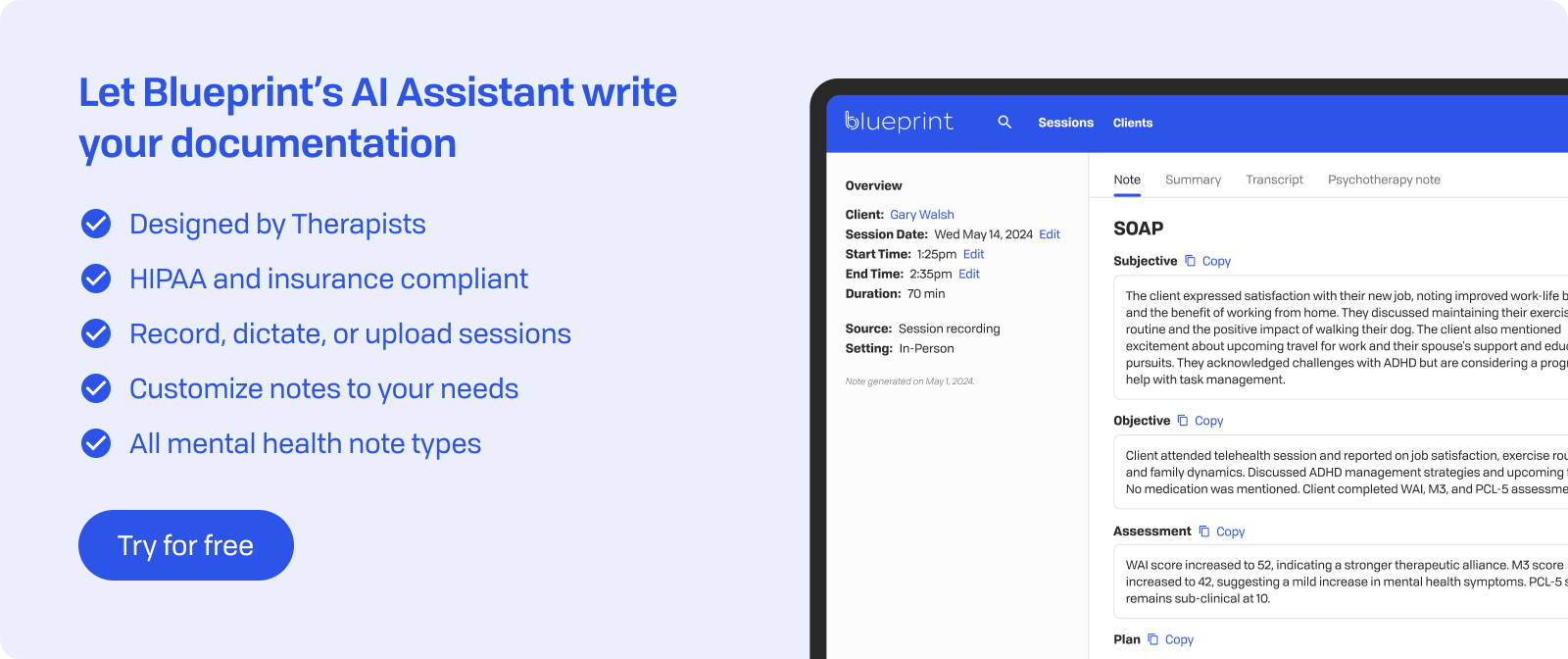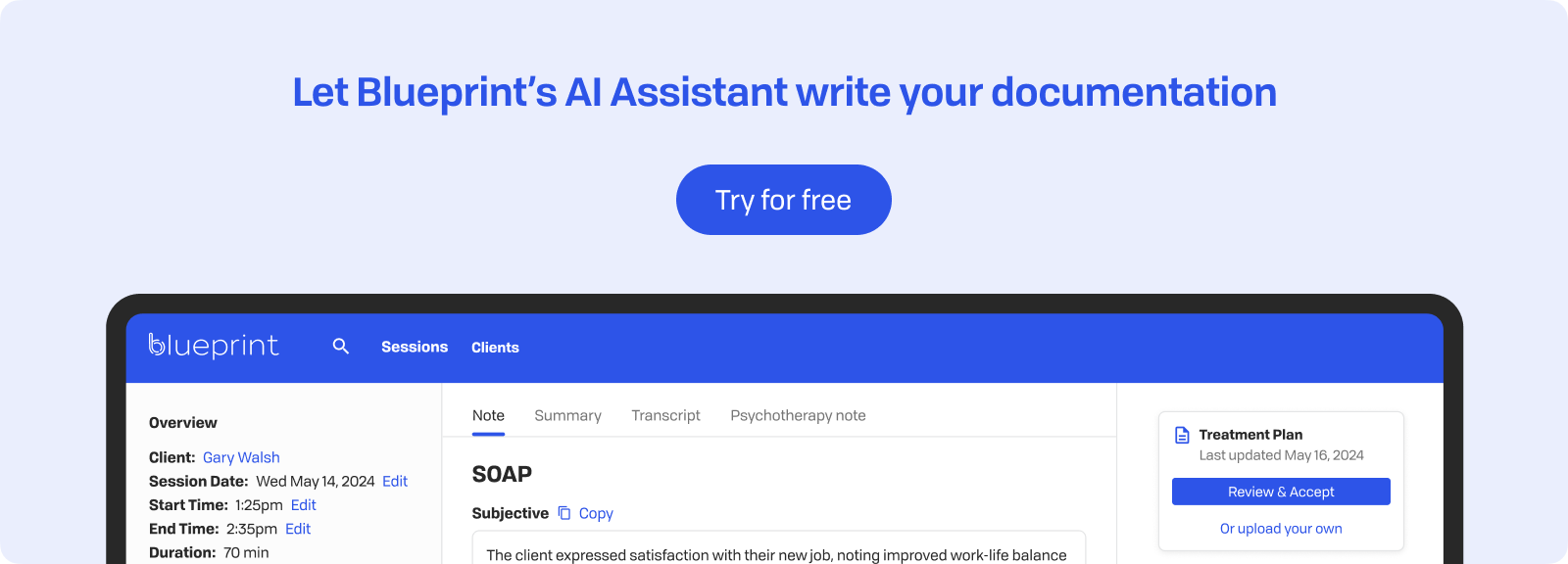In Brief
You've probably noticed the terms "counseling" and "therapy" often being used interchangeably in professional settings, client conversations, and even insurance documentation. This overlap can lead to confusion about practice scope, intervention methods, and professional identity. The distinction—or lack thereof—between these terms affects how we view our work and communicate with clients.
The debate surrounding counseling versus therapy isn't just about words. It involves fundamental questions about professional training, regulatory requirements, and the interventions we're qualified to offer. Knowing these differences helps us make informed decisions about our practice boundaries and ensures we accurately represent our services to clients and colleagues.
This discussion aims to clarify the professional and regulatory differences between counseling and therapy, look at typical practice settings, and address credentialing differences. A deeper understanding of these terms allows us to provide better patient care and communicate more effectively about our professional roles and skills.
Historical Origins & Theoretical Foundations
Counseling and therapy have different historical roots, reflecting unique societal needs and professional growth. Counseling began mainly in vocational guidance and educational settings in the early 20th century. Frank Parsons, often called the father of vocational guidance, established counseling as a profession focused on helping individuals make career and life decisions. This practical, solution-focused approach emphasized normal developmental challenges and adjustment issues.
On the other hand, therapy traces its origins to medical and psychiatric traditions, particularly through Freud's psychoanalytic work in the late 19th century. This foundation stressed unconscious processes, early childhood experiences, and the treatment of mental illness. The medical model underlying therapy positioned practitioners as experts treating pathology, rather than guides facilitating personal growth.
While these historical roots set the stage for distinct professional identities, today’s practice often blends counseling’s developmental focus with therapy’s clinical depth, making clarity even more important.

Defining Counseling in Contemporary Practice
One challenge in distinguishing counseling from therapy is that the term counseling doesn’t always refer to the same scope of practice. In some contexts, counseling is essentially another word for psychotherapy; in others, it refers to structured support that does not require a mental health license.
Licensed Counseling as Psychotherapy
In the U.S., many professionals with titles such as Licensed Professional Counselor (LPC), Licensed Mental Health Counselor (LMHC), or Licensed Clinical Professional Counselor (LCPC) provide psychotherapy that is indistinguishable from what a psychologist or clinical social worker might offer. These counselors assess, diagnose, and treat mental health conditions, often using evidence‑based modalities like CBT or EMDR. In this context, counseling is legally and clinically equivalent to therapy.
Counseling as Guidance or Support
In other settings, counseling refers to structured support that may not involve diagnosing or treating mental illness. Examples include school counselors, who focus on academic and social development rather than mental health treatment, and Certified Alcohol and Drug Abuse Counselors (CADACs), who provide substance use counseling under defined scopes of practice. These roles often require certification but not a clinical license, and they may emphasize education, prevention, and support rather than full‑scope psychotherapy.
This variation means that the word counseling must always be understood in context—considering the provider’s training, credentialing, and legal scope of practice. For clients, clarifying these distinctions helps set accurate expectations; for clinicians, it ensures we represent our qualifications and services transparently.
Scope of Practice & Clinical Focus
The scope of counseling and therapy varies widely, shaped by credentialing, training, and regulatory frameworks. While both may involve supporting clients through emotional and relational challenges, the extent of assessment, diagnosis, and treatment often depends on professional role and license.
Counseling
In some contexts—such as with Licensed Professional Counselors (LPCs), Licensed Clinical Professional Counselors (LCPCs), or Licensed Mental Health Counselors (LMHCs)—counselors can offer full‑scope psychotherapy. These professionals assess, diagnose, and treat mental health disorders, often using structured, evidence‑based interventions.
In other contexts, however, counseling is more narrowly defined. Examples include:
- School Counselors — Focus on academic planning, career guidance, and social development rather than clinical treatment.
- Certified Alcohol and Drug Abuse Counselors (CADACs) — Provide education, relapse prevention, and recovery support; may require referral for co‑occurring mental health treatment.
- Pastoral or Faith‑Based Counselors — Offer spiritual and emotional support within religious frameworks; licensure requirements vary.
- Career Counselors — Help clients explore vocational goals, job transitions, and workplace challenges rather than mental health diagnoses.
These roles provide valuable guidance and support but may not include the authority to diagnose or treat mental health conditions unless additional clinical licensure is held.

Therapy
The term therapy traditionally implies a clinical role centered on the treatment of diagnosable mental health conditions. Psychologists, clinical social workers, marriage and family therapists, and licensed professional counselors use psychotherapy to address a broad range of mental, emotional, and behavioral health concerns. Therapy often involves more intensive exploration of underlying issues and may include longer‑term treatment planning.
Therapy can address a wide range of concerns and be delivered in different formats:
- Formats of Therapy
- Individual therapy
- Couples therapy
- Family therapy
- Group therapy
- Common Issues Therapy Helps With
- Depression and other mood disorders
- Anxiety disorders and phobias
- Trauma and posttraumatic stress disorder (PTSD)
- Relationship and marital difficulties
- Substance use and addictive behaviors
- Grief and loss
- Personality disorders
- Stress management and adjustment challenges
Ultimately, clarifying scope of practice helps clinicians communicate transparently about what they offer and helps clients understand what to expect from their care.
Skill Sets & Professional Competencies
The skills emphasized in non-licensed counseling versus therapy reflect their distinct professional orientations and client needs. Counselors typically focus on:
- Active listening and empathy: Creating safe spaces where clients feel heard and validated
- Goal-setting and action planning: Helping clients identify concrete objectives and develop practical strategies
- Psychoeducation: Teaching coping skills, stress management techniques, and healthy communication patterns
- Brief intervention techniques: Using solution-focused approaches and motivational interviewing
Therapists often provide services using additional skills, including:
- Diagnostic assessment: Conducting comprehensive evaluations using DSM-5-TR criteria
- Clinical formulation: Developing detailed conceptualizations of client presentations
- Evidence-based interventions: Implementing structured treatments like CBT or EMDR
- Complex case management: Coordinating care for clients with multiple diagnoses
Training pathways differ significantly between non‑licensed counseling roles and clinical therapy professions.
Non‑Licensed Counseling Roles
These typically require certification or graduate‑level coursework rather than a clinical license. For example, school counselors often complete a master’s degree in school counseling and meet state certification or licensing requirements by an educational board, but their role focuses on academic, career, and social development rather than diagnosing mental health disorders. Similarly, Certified Alcohol and Drug Abuse Counselors (CADACs) complete specialized training and supervised practice in addiction counseling. While their expertise is vital in recovery support, they may not provide full‑scope psychotherapy without additional licensure.
Psychotherapy Providers, including Licensed Counselors
Among mental health professionals, licensed counselors are part of a broader group of psychotherapy providers that also includes clinical social workers, marriage and family therapists, and psychologists. These clinicians are trained to deliver comprehensive mental health treatment and typically hold advanced degrees in their respective fields.
- Licensed Counselors: Licensed Professional Counselors (LPCs), Licensed Clinical Professional Counselors (LCPCs), and Licensed Mental Health Counselors (LMHCs) usually complete a master’s degree in counseling, thousands of supervised clinical hours, and state or national licensing exams. Their training equips them to conduct diagnostic assessments, create clinical formulations, and implement evidence‑based interventions such as CBT, DBT, or EMDR.

Other Psychotherapy Providers
- Clinical Social Workers (LCSWs): Complete a Master of Social Work (MSW) with clinical specialization and supervised practice. They are licensed to diagnose and treat mental health disorders, often with additional expertise in systems work and case management.
- Marriage and Family Therapists (LMFTs): Trained at the master’s level with a focus on relational and systemic therapy, LMFTs specialize in treating couples, families, and individuals in the context of their relationships.
- Psychologists (Ph.D. or Psy.D.): Complete doctoral‑level training that includes advanced coursework, clinical practica, internships, and often postdoctoral supervised practice. Their training emphasizes both psychotherapy and psychological assessment.
Together, these psychotherapy providers offer a wide range of services, from brief solution‑focused interventions to longer‑term treatment of complex mental health conditions. While their approaches may differ, all share the legal authority to diagnose, treat, and document mental health disorders, ensuring care that meets clinical and reimbursement standards.
Client Engagement & Treatment Planning
Regardless of whether services are provided under the title of counseling or therapy, successful outcomes depend heavily on how clinicians engage clients and structure the treatment process. Clear communication, goal alignment, and collaborative planning form the backbone of effective care.
Building Engagement
The first step is establishing trust. Clients are more likely to participate actively when they feel heard, respected, and involved in decisions about their care. Counselors often emphasize rapport‑building and motivational interviewing, helping clients feel invested in the process. Therapists may combine these approaches with more formal assessment feedback and psychoeducation, ensuring clients understand their diagnoses and treatment options.
Developing a Treatment Plan
Treatment planning should be tailored to the individual’s needs and scope of care. Key elements include:
- Assessment of presenting concerns: Using clinical interviews, standardized measures, and collateral information when appropriate.
- Goal‑setting: Identifying concrete, measurable objectives that reflect the client’s priorities.
- Intervention strategies: Selecting evidence‑based approaches—such as CBT, DBT, EMDR, or solution‑focused techniques—based on clinical formulation and client readiness.
- Frequency and format of sessions: Determined by the severity of symptoms, available resources, and insurance or regulatory guidelines.
- Review and adjustment: Regularly evaluating progress and updating goals or methods as needed.
The Role of Documentation
In both counseling and therapy, treatment planning is not just a clinical task but also an ethical and regulatory requirement. Documenting goals, progress, and interventions supports continuity of care, demonstrates medical necessity for reimbursement, and provides transparency for clients.
By prioritizing engagement and structured planning, clinicians ensure that interventions are not only clinically appropriate but also meaningful to the client’s lived experience.

Outcomes, Evaluation & Evidence Base
Understanding the effectiveness of counseling and therapy requires looking at both client‑reported outcomes and the broader research base supporting each approach. While the terms differ in scope and credentialing, both counseling and therapy share a commitment to measurable progress and evidence‑informed practice.
Evaluating Outcomes
Therapists and counselors alike use a combination of methods to assess client progress, such as:
- Symptom measures: Standardized tools like the PHQ‑9 (for depression), GAD‑7 (for anxiety), or child‑focused measures to track changes over time.
- Functional outcomes: Improvements in relationships, academic or work performance, daily living skills, and overall quality of life.
- Client feedback: Session‑by‑session check‑ins or structured feedback systems that highlight therapeutic alliance and perceived benefit.
- Behavioral indicators: Reduced crisis incidents, fewer disciplinary actions, or greater adherence to treatment recommendations.
Evidence Base for Counseling and Therapy
- Counseling: Historically rooted in developmental and vocational guidance, counseling has built an evidence base around solution‑focused brief therapy, motivational interviewing, and psychoeducational approaches. These methods are especially effective for adjustment issues, career guidance, and specific life stressors.
- Therapy: Clinical psychotherapy has a long record of research support across modalities. Evidence‑based treatments such as Cognitive Behavioral Therapy (CBT), Dialectical Behavior Therapy (DBT), and Eye Movement Desensitization and Reprocessing (EMDR) have demonstrated effectiveness in treating depression, anxiety disorders, PTSD, substance use disorders, and personality disorders.
Why Evaluation Matters
Regular outcome evaluation ensures that treatment remains responsive to the client’s needs and aligns with both ethical standards and insurance requirements. It also helps clinicians demonstrate the value of their work, both to clients and to the systems in which they practice.
By grounding interventions in evidence while tailoring them to individual goals, both counselors and therapists can maximize effectiveness, accountability, and client well‑being.
Key Takeaways
Counseling and therapy differ mainly in terms of depth, duration, and clinical focus. Counseling from a non-licensed counselor often deals with specific issues and tends to be short-term with solution-focused interventions, while therapy, including treatment from a licensed counselor, addresses more complex psychological conditions, including through evaluation and diagnosis.
Knowing these distinctions can improve professional practice in several ways:
- Clear communication: Use precise language when discussing cases with colleagues, writing treatment plans, or explaining services to clients.
- Awareness of practice limits: Recognize when a client's needs exceed your training and make appropriate referrals.
- Treatment planning: Match the intensity of interventions to the complexity of the problem for the best outcomes.
- Ethical decision-making: Stay within your competency limits while addressing client needs.
Practical applications for daily practice include:
- Assessment approach: Use brief screening tools for counseling-focused work and comprehensive assessments for therapy cases.
- Goal-setting: Set concrete objectives for counseling (such as skill-building or problem-solving) and broader goals for therapy (like personality change or trauma resolution).
- Session structure: Adjust your approach based on the client's presentation and needs
- Documentation: Tailor your notes to reflect your approach—focus on behavioral observations and action plans for counseling and evidence-based clinical interventions for therapy.
- Professional development: Seek training to expand your skills while respecting the distinct abilities required for each approach.
These insights support providing care that is more tailored and ethically sound, meeting each client's unique needs and circumstances.

How Blueprint can help streamline your workflow
Blueprint is a HIPAA-compliant AI Assistant built with therapists, for the way therapists work. Trusted by over 50,000 clinicians, Blueprint automates progress notes, drafts smart treatment plans, and surfaces actionable insights before, during, and after every client session. That means saving about 5-10 hours each week — so you have more time to focus on what matters most to you.
Try your first five sessions of Blueprint for free. No credit card required, with a 60-day money-back guarantee.
























